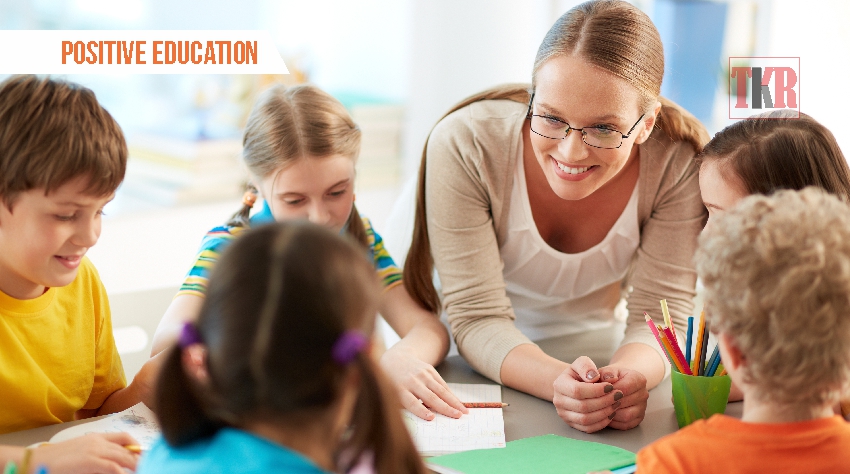Positive education falls under the column of positive psychology and uses methods to promote mental health and well-being. It deals with aspects such as general well-being, happiness, and resilience of the students. The idea is to send a child to a school where, he/she can learn, read, write and flourish. Positive education merges flourishing aspects-engagements, emotional engagement, accomplishments, meaning, and positive relationships- with conventional education methods. In traditional schools, wherein the focus is on academic performance, positive education strengthens the child’s well-being and social responsibilities.
Martin Seligman, an American psychologist, formulated the idea of 5 elements and named it as PERMA model, which takes care of the social well-being of happiness.
P-Possible Emotions- the emotions of joy, gratitude, and hope
E-Engagement- getting absorbed in activities and challenging the honed skills
R-Relationships- having positive relationships
M-Meaning- belonging and serving the greater good, which is higher than you are
A-Accomplishment- pursuing success, winning assignments and mastering skills
According to Seligman, positive education bridges the gap between the parent’s need towards the child and what the school teaches. Every parent wants their children to be happy, healthy, and confident to attain discipline and academic skills. Students can only accomplish these results with healthy mental well-being. Fixing the gap, positive education constitutes an environment where school teachers aid students in achieving success with overall good mental health skills. In more simple terms, positive education brings positive psychology goals of well-being and mental health support for everyone present in the school setting.
Does it Really Work?
Yes, it works. The interventions practiced in positive education such as decision-making skills, coping skills, problem-solving skills, creative brainstorming, and relaxation assists in obtaining stable emotional states. These techniques improve mental health and life satisfaction, reduces depression and anxiety and improves academic success alongside creative thinking. However, the factors such as a difference in training support for the staff and resources available may alter the desired outcome.
The Classroom can make a Difference
Classroom engagement is the most important part of positive education. This is where a connection is made between the students and the teacher. Classic class engagement can certainly aid in developing a bond between a teacher and the students. The problem emerges when the participating students are of different levels and the same voice can dominate the entire class. An approach to overcome this obstacle is to grant participation credits, not to
individuals, but to the groups. The class can be partitioned into small groups comprising both the high-participating and low-participating students equally and offering credit to the entire group if all the members of the group participate. The result can be viewed in the form of enlarged participation from the low-level group. An added benefit is that the high-level group can educate the low-level group and both can gain credits by doubling the participation level.
Another crucial aspect of class engagement is the happiness of both parties. Positive education is not only for students, but can also be directed towards the teachers, because a happy teacher is directly proportional to happy students.
Teachers that feel burdened can affect the academic and emotional needs of the students. Hence, teachers’ increased workout should also be considered. Researches also point out that the educator with inadequate wages also affects the outcomes. Teachers that assume that their wages are little can show the lack of emotional support. On the contrary, teachers with sufficient wages can be seen with students who demonstrate more positive and emotional expressions and behaviors. Hence, these findings confirm that the teachers’ wages are likely to improve emotional outcomes of students.
Practicing Positive Education with Worksheets
Here are some of the worksheets that can help in spreading positive environment around the school:
Good Things Worksheet; this is a simple worksheet and includes adding 3 good things that happened to students every day and they can reflect on those things. After each day, every student reflects why those good things happened and how they can be successful in performing them often.
Positive Steps; this simple worksheet includes simple things to be kept in mind for well-being. It can include tips for keeping perspectives, exercising, sleeping, relaxing, and connecting with others and many more. Such list can be kept in the school lockers or can be hanged in the class for easy and constant reminder.
Daily Mood charts; this worksheet can assist student in tracking their mood throughout the day. With this help, they can understand their mood and reflect on the same. Teachers can use it as a group mood chart to track class’s engagement levels.
Role of Parents and School
The parents and teacher role in positive education are mentioned below:
Parent’s role:
* To praise the child for efforts, rather than for intelligence
* Provide a consistent environment and family routines
* Take interests in what their children are doing
* Encouraging free time by playing outside other than spending time on electronic devices to enhance imagination and creativity
* Help children in realizing true strength
* Assign in-home jobs to develop sense of responsibilities and self-mastery
* To master challenges and overcoming frustrations with optimistic approach
School’s Role:
The first role of the schools is to converse with other schools and institutions to share their journey of positive education and benefit from shared knowledge, resources, and experience.
* Assessing what have been working for them
* Accept PREMA model
* Embedding positive education strategies
* Evaluating children’s results and accessing the effectiveness
Positive education is not a unique concept but is a reaffirmation of where the education provider’s and receiver’s end goal should be. It does not take one to research and discover that being happy and emotionally stable will yield stronger academic results. Therefore, schools should encourage positive psychology. They must also be careful while not to burden the teacher while doing so and must take care of their well-being ensuring a calm, emotional, and solid academic outcomes of the students.
— Anmol Preet Singh









